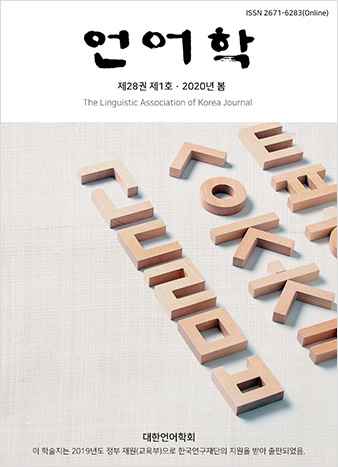대한언어학회 전자저널

28권 1호 (2020년 3월)
- Q-movement in Korean
-
Youngjae An
Pages : 99-106
Abstract
An, Youngjae. (2020). Q-movement in Korean. The Linguistic Association of Korea Journal, 28(1), 99-106. In this paper, I attempt to demonstrate that wh-question formation in Korean involves movement of a Q(uestion)-particle. Along the lines of Q-movement by Cable (2010) and Hagstrom (1998), I argue that the wh-question in Korean is derived by the movement of the Q-particle. This mechanism accounts not only for how the interpretation of the wh-word is achieved by the Q-particle but also for why the wh-word in Korean remains in situ. I argue further that the EPP on C is involved in successive cyclic Q-movement in Korean, which accounts for certain alleged island effects in Korean.
Keywords
# wh-questions in Korean # Q-particle # island effects # successive cyclic movement
References
- Alexiadou, A., & Anagnostopoulou, E. (1998). Parametrizing Agr: Word order, V-movement and EPP-checking. Natural Language and Linguistic Theory, 16, 491-539.
- Boeckx, C. (2008). Understanding minimalist syntax: Lessons from locality in long-distance dependencies. Malden, MA: Blackwell.
- Cable, S. (2010). The grammar of Q: Q-particles, wh-movement, and pied-piping. Oxford: Oxford University Press.
- Cheng, L., & Rooryck, J. (2000). Licensing wh-in situ. Syntax, 3, 1-19.
- Choe, H.-S. (1994). Syntactic wh-movement in Korean and licensing. In Y. Kim-Renaud (Ed.), Theoretical issues in Korean linguistics (pp. 275-302). Stanford, CA: Center for the Study of Language and Information.
- Chomsky, N. (1995). The minimalist program. Cambridge, MA: MIT Press.
- Chomsky, N. (2000). Minimalist inquiries. In R. Martin, D. Michaels, & J. Uriagereka (Eds.), Step by step: Essays on minimalist syntax in honor of Howard Lasnik (pp. 89-155). Cambridge, MA: MIT Press.
- Chomsky, N. (2001). Derivation by phase. In M. J. Kenstowicz (Ed.), Ken Hale: A life in language (pp. 1-52). Cambridge, MA: MIT Press.
- Chung, D.-H. (1996). On the representation of Q and Q-dependencies. Unpublished doctoral dissertation, University of Southern California.
- Hagstrom, P. (1998). Decomposing questions. Unpublished doctoral dissertation, Massachusetts Institute of Technology.
- Heim, I. (1982). The semantics of definite and indefinite noun phrases. Unpublished doctoral dissertation, University of Massachusetts.
- Hong, S.-H. (2005). Aspects of the syntax of wh-questions in English and Korean. Unpublished doctoral dissertation, University of Essex.
- Kim, A.-R. (2001). Korean wh-phrases void of operator. Japanese/Korean Linguistics, 9, 311-324.
- Kim, Y.-H. (2006). Q-particles vs. I-particles: Licensors of the Question and the Indefinite wh-words. Studies in Generative Grammar, 16(3), 461-490.
- Lee. J.-C. (2006). Wh-islands and additional wh-effects. Studies in Modern Grammar, 43, 1-31.
- Miyagawa, S. (2001). The EPP, scrambling, and wh-in-situ. In Kenstowicz. M (Ed.), Ken Hale: A life in language (pp. 293-338). Cambridge, MA: MIT Press.
- Rizzi, L. (2013). Locality. Lingua, 130, 169-186.
- Roberts, I. (2010). Agreement and head movement: Clitics, incorporation, and defective goals. Cambridge, MA: MIT Press.
- Yoon, J.-M. (1999). Decomposing wh-question formation: Wh-in-situ and island constraint in Korean. Studies in Generative Grammar, 9(2), 153-198.
- Yoon, J.-M. (2012). Wh-island effects in Korean wh-in-situ questions: Degradedness or misinterpretation? Korean Journal of Linguistics, 37(2), 357-382.